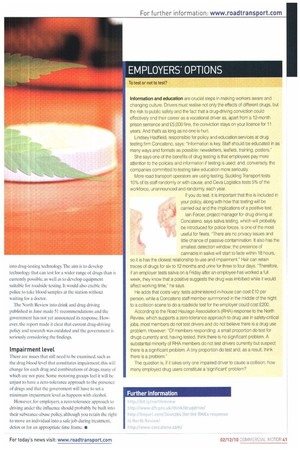EMPLOYERS' OPTIONS
Page 41

If you've noticed an error in this article please click here to report it so we can fix it.
To test or not to test?
Information and education are crucial steps in making workers aware and changing culture. Drivers must realise not only the effects of different drugs, but the risk to public safety and the fact that a drug-driving conviction could effectively end their career as a vocational driver as, apart from a 12-month prison sentence and £5,000 fine, the conviction stays on your licence for 11 years. And that's as long as no one is hurt.
Lindsey Hadfield, responsible for policy and education services at drug testing firm Concateno, says: "Information is key. Staff should be educated in as many ways and formats as possible: newsletters, leaflets, training, posters."
She says one of the benefits of drug testing is that employees pay more attention to the policies and information if testing is used; and, conversely, the companies committed to testing take education more seriously.
More road transport operators are using testing. Suckling Transport tests 10% of its staff randomly or with cause, and Ceva Logistics tests 5% of the workforce, unannounced and randomly, each year.
If you do test, it is important that this is included in your policy, along with how that testing will be carried out and the implications of a positive test.
lain Forcer, project manager for drug driving at Concateno, says saliva testing, which will probably be introduced for police forces, is one of the most useful for fleets. "There are no privacy issues and little chance of passive contamination. It also has the smallest detection window; the presence of cannabis in saliva will start to fade within 18 hours, so it is has the closest relationship to use and impairment." Hair can retain traces of drugs for six to 12 months and urine for three to four days. "Therefore, if an employer tests saliva on a Friday after an employee has worked a full week, they know that a positive suggests the drug was imbibed while it would affect working time," he says.
He adds that costs vary: tests administered in-house can cost £10 per person, while a Concateno staff member summoned in the middle of the night to a collision scene to do a roadside test for the employer could cost £200.
According to the Road Haulage Association's (RHA) response to the North Review, which supports a zero-tolerance approach to drug use in safety-critical jobs, most members do not test drivers and do not believe there is a drug use problem. However: "Of members responding. a small proportion do test for drugs currently and, having tested, think there is no significant problem. A substantial minority of RHA members do flattest drivers currently but suspect there is a significant problem. A tiny proportion do test and, as a result, think there is a problem."
The question is, if it takes only one impaired driver to cause a collision, how many employed drug users constitute a 'significant' problem?
































































































































